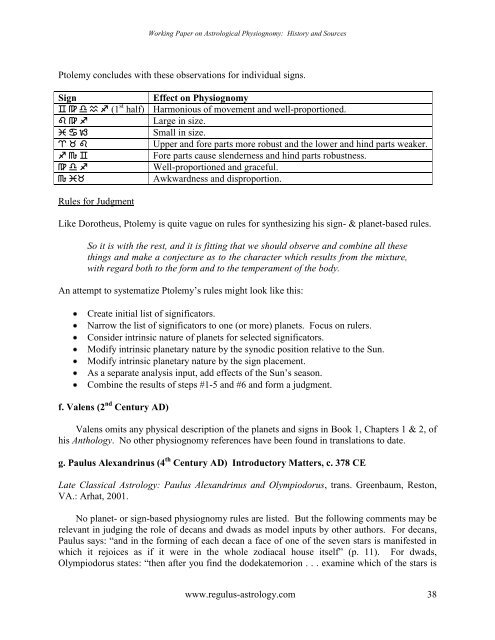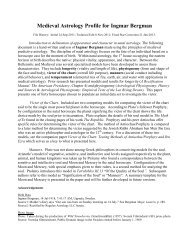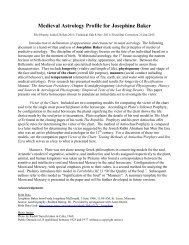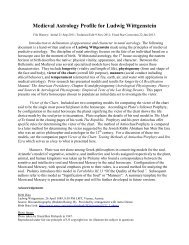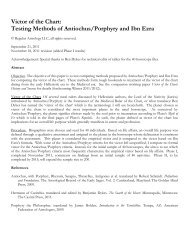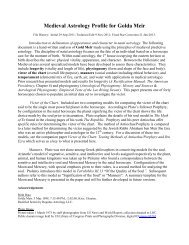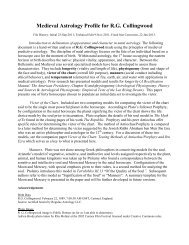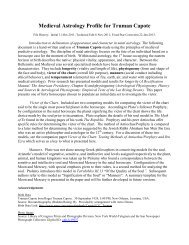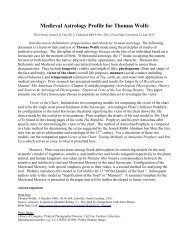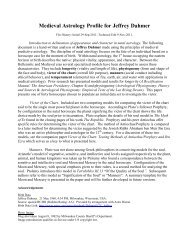Working Paper on Astrological Physiognomy: History and Sources
Working Paper on Astrological Physiognomy: History and Sources
Working Paper on Astrological Physiognomy: History and Sources
Create successful ePaper yourself
Turn your PDF publications into a flip-book with our unique Google optimized e-Paper software.
<str<strong>on</strong>g>Working</str<strong>on</strong>g> <str<strong>on</strong>g>Paper</str<strong>on</strong>g> <strong>on</strong> <strong>Astrological</strong> <strong>Physiognomy</strong>: <strong>History</strong> <strong>and</strong> <strong>Sources</strong><br />
Ptolemy c<strong>on</strong>cludes with these observati<strong>on</strong>s for individual signs.<br />
Sign Effect <strong>on</strong> <strong>Physiognomy</strong><br />
R U V Z X (1 st half) Harm<strong>on</strong>ious of movement <strong>and</strong> well-proporti<strong>on</strong>ed.<br />
T U X Large in size.<br />
[ S Y Small in size.<br />
P Q T Upper <strong>and</strong> fore parts more robust <strong>and</strong> the lower <strong>and</strong> hind parts weaker.<br />
X W R Fore parts cause slenderness <strong>and</strong> hind parts robustness.<br />
U V X Well-proporti<strong>on</strong>ed <strong>and</strong> graceful.<br />
W [Q Awkwardness <strong>and</strong> disproporti<strong>on</strong>.<br />
Rules for Judgment<br />
Like Dorotheus, Ptolemy is quite vague <strong>on</strong> rules for synthesizing his sign- & planet-based rules.<br />
So it is with the rest, <strong>and</strong> it is fitting that we should observe <strong>and</strong> combine all these<br />
things <strong>and</strong> make a c<strong>on</strong>jecture as to the character which results from the mixture,<br />
with regard both to the form <strong>and</strong> to the temperament of the body.<br />
An attempt to systematize Ptolemy’s rules might look like this:<br />
Create initial list of significators.<br />
Narrow the list of significators to <strong>on</strong>e (or more) planets. Focus <strong>on</strong> rulers.<br />
C<strong>on</strong>sider intrinsic nature of planets for selected significators.<br />
Modify intrinsic planetary nature by the synodic positi<strong>on</strong> relative to the Sun.<br />
Modify intrinsic planetary nature by the sign placement.<br />
As a separate analysis input, add effects of the Sun’s seas<strong>on</strong>.<br />
Combine the results of steps #1-5 <strong>and</strong> #6 <strong>and</strong> form a judgment.<br />
f. Valens (2 nd Century AD)<br />
Valens omits any physical descripti<strong>on</strong> of the planets <strong>and</strong> signs in Book 1, Chapters 1 & 2, of<br />
his Anthology. No other physiognomy references have been found in translati<strong>on</strong>s to date.<br />
g. Paulus Alex<strong>and</strong>rinus (4 th Century AD) Introductory Matters, c. 378 CE<br />
Late Classical Astrology: Paulus Alex<strong>and</strong>rinus <strong>and</strong> Olympiodorus, trans. Greenbaum, Rest<strong>on</strong>,<br />
VA.: Arhat, 2001.<br />
No planet- or sign-based physiognomy rules are listed. But the following comments may be<br />
relevant in judging the role of decans <strong>and</strong> dwads as model inputs by other authors. For decans,<br />
Paulus says: “<strong>and</strong> in the forming of each decan a face of <strong>on</strong>e of the seven stars is manifested in<br />
which it rejoices as if it were in the whole zodiacal house itself” (p. 11). For dwads,<br />
Olympiodorus states: “then after you find the dodekatemori<strong>on</strong> . . . examine which of the stars is<br />
www.regulus-astrology.com<br />
38


